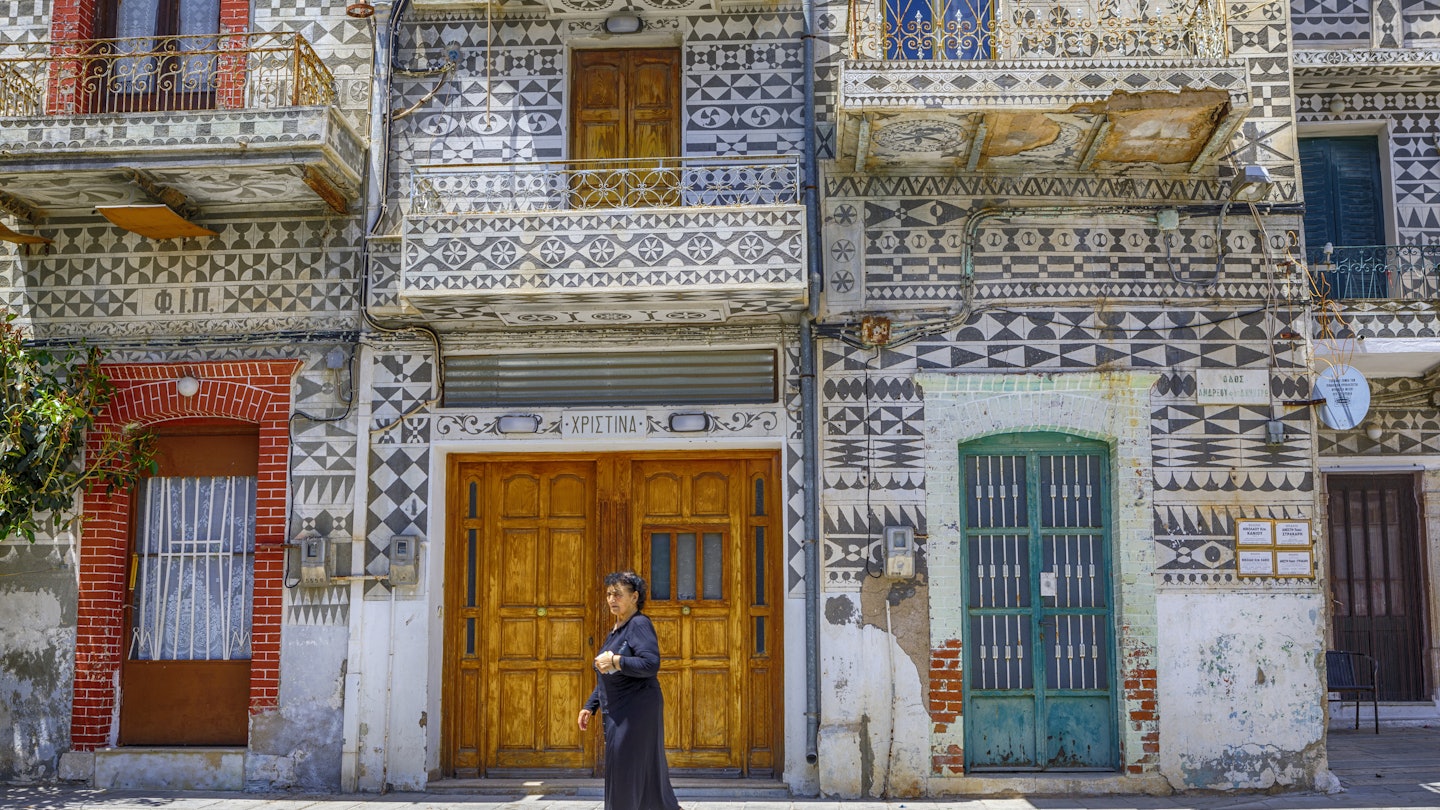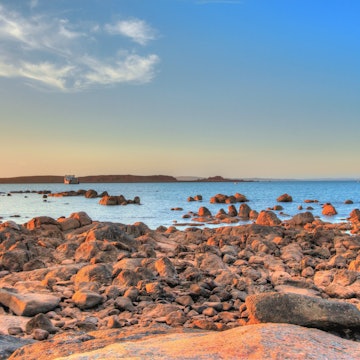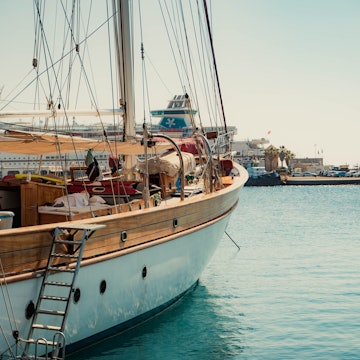

Pyrgi village on the Greek island of Chios is known for its xysta designs. tunart/Getty Images
Life in Greece has always taken place in public view, whether that means old-timers talking politics at the local kafeneio (coffee house) or families gathering in neighborhood squares while the kids play late into the evening. And Greek villages, from seashore hubs to mountain escapes, are quintessential places to experience daily life in the Med – and to practice using a few words of Greek!
If you want to dive into some local life on a trip to Greece, here are the best places to experience village life.


1. Mastihohoria, Chios, North Aegean
The sun-dried hills in the south of the island of Chios are covered in mastic plantations, which gave the island its fame. Though mastic trees do grow elsewhere in the Aegean, Chios has for centuries been the sole commercial producer of mastic gum, used to make chewing gum, food and medicine.
The mastic trees thrive in a fertile, reddish territory known as the Mastihohoria; its stunning medieval villages, each uniquely designed, were built as fortresses protecting farmers from invaders and pirates. The region’s main draw is that a number of the old stone houses have been converted into boutique hotels and pensions, providing highly atmospheric accommodation.
The Mastihohoria’s largest village, Pyrgi, looks like a magic jewelry box, with house facades decorated in intricate gray-and-white patterns, some geometric and others based on flowers, leaves and animals. The technique used to create these designs, called xysta, uses equal amounts of cement, volcanic sand and lime (calcium oxide), as well as a bent fork and a fine eye. Another highlight is Pyrgi’s central square – flanked by tavernas, shops and the little 12th-century Church of Agios Apostolos.
A short trip to the northwest, Mesta is just as memorable. Its romantic stone alleyways, adorned with flowers and intricate balconies, are completely enclosed by thick defensive walls – the work of Chios’ former Genoese rulers, who built this fortress town in the 14th century.
The village is an ingenious example of medieval defensive architecture, featuring a double set of walls, four gates and a pentagonal structure, with the larger of two impressive Churches of the Taxiarhes at the center. Connected to Mesta by a scenic monopati (a traditional trail now used by hikers), Olymbi is a smaller and less crowded version of the same idea, with a few quality tavernas.

2. Apiranthos, Naxos, Cyclades
Apiranthos grows out of the rocky flanks of 883m (2897ft) Mt Fanari on the island of Naxos, and its unadorned stone houses and marble-paved streets reflect a rugged sense of individualism that is matched by the villagers themselves.
Many residents are descendants of refugees from Crete, and the village’s distinctive dialect reflects this heritage. These days, the village is best known for its crafts, including weaving using traditional argalio or krevataria looms. Learn more at the Women's Association of Traditional Art, where they also sell homemade sweets.
Afterward, while away the afternoon at local cafes or Apiranthos' excellent tavernas. Try Lefteris for meat dishes, Amorginos for traditional island fare with a view, and Bakalogatos for mezedhes (small plates).

3. Tinos, Cyclades
The countryside of the island of Tinos is a glorious mix of broad terraced hillsides, mountaintops crowned by rugged crags and more than 50 unspoiled villages with fascinating architecture. From any one of these tiny whitewashed hamlets, others can be seen in the distance. Take your time hopping from village to village through this charming area.
Just north of Hora, the island's main town, beautiful Ktikados perches in a hanging valley, with a good taverna and a skyline punctuated by a blue-domed church with an elegant campanile. Nearby, Kampos sits atop a scenic hill surrounded by fields; it's home to the Costas Tsoclis Museum, displaying works by the renowned contemporary artist.
Don’t miss Tarabados, a maze of small streets, blue-shuttered houses and marble sculptures (excellent signage details local history). Right in the middle of the island, Loutra is like the local cats, a mix of the derelict and the well-tended. It's dominated by the enormous and slightly spooky Urasaline Monastery.
To the northwest, tiny Aetofolia clings to a hillside overlooking yet another verdant valley. A minor detour takes you to ethereal Agapi, a pretty village set in a lush valley full of dovecotes. Nearby, Volax sits at the heart of an amphitheater of low hills festooned with hundreds of enormous and incongruous multicolored boulders. There are fine hikes, long and short, around the village, which is noted for its shops and tavernas.
More villages cling to slopes above the northwest coast. Lovely Kardiani perches on a steep cliff slope, with tiny lanes winding up and down, passing a church with sweeping views. Charming Isternia could be called "the balcony of Europe," with views over an island-studded bay.

4. Amorgos, Cyclades
The dramatic island of Amorgos is shaped like a seahorse swimming east towards the Dodecanese. The ribbon of road that winds its way along the island's long ridge of mountains, connecting the main villages, is among the most beautiful drives in the Cyclades, offering views in all directions.
The island remains relatively off the beaten track – even the fast ferry from Athens takes seven hours to get here. Of the three main villages, bustling Katapola is favored by families, while Aegiali attracts a younger crowd, and the enchanting island capital of Hora is maze-like, with marble-paved alleyways and tumbling bougainvillea.
Nestled amid the craggy slopes above Aegiali, the small villages of Langada and Tholaria are picturesque tangles of whitewashed lanes with excellent tavernas, plus shops selling beautiful, locally produced crafts. All three villages are linked by walking trails, running both to each other and to other parts of the island.
For a dose of history, Tholaria sits near the ruins of ancient Aegiali; the millennia-old, yet-to-be-excavated settlement is an easy 10-minute walk from the village.

5. Dikeos mountain villages, Kos, Dodecanese
Scattered across the green slopes of the Dikeos mountains, Kos' villages are real gems. Your first stop should be Agios Dimitrios, an abandoned village whose resident population departed during WWII. Here, you'll find a stunning cafe, Haihoutes, and a gorgeous village church.
Next head to the mountain village of Lagoudi Zia, 14km (9 miles) southwest of Kos Town. Formerly one of Kos' prettiest villages, it's now essentially a one-street theme park, though the views down to the sea are as wonderful as ever.
Coachloads of tourists are deposited every few minutes to stroll along its row of souvenir shops and competing tavernas. If you continue further on, you'll reach the village of Asfendiou, where you'll be rewarded with great views and incredible churches, and most likely have them to yourself.
Continuing around 5km (3 miles) further west, you'll reach the less commercialized village of Pyli. Just before the village, a left turn leads to the extensive remains of its medieval predecessor, Old Pyli, scattered amid the towering rocks and pine trees of a high and rather magical hillside. The summit is crowned by the stark ruins of Pyli Castle, and the whole place is so wild you half expect Pan, god of the wild and shepherds, to pop up and say hello.
A well-marked trail climbs from the roadside parking area, forking left to the castle and right to the old village, where the only building still in use is the Oria Tavern, hidden away in the woods. Buses connect Kos Town with Pyli (two to four daily), but not Old Pyli.

6. Kardamyli, Peloponnese
Between the blue waters of the Messinian Gulf and the Taÿgetos Mountain sits what's reputed to be one of the prettiest villages in the Peloponnese, and that takes some beating. Kardamyli, a 50-minute drive and 35km (22 miles) away from Kalamata on the Greek mainland, is famed for being the spot where British travel writer Sir Patrick Leigh Fermor set up home in the 1960s.
One of the best ways to appreciate the sheer beauty of this region is to take a sea kayaking tour along the coastline. You'll uncover sea caves with stalactites, and, in very calm weather, you can paddle into the Blue Cave to observe sunlight passing through a crack in the cave roof and reflecting on the seabed, bathing everything in an aquamarine glow.
If hiking is more your thing, trails in the Taÿgetos Mountains and the area around Kardamyli will take you past villages, stone houses, Byzantine churches, stone-built watchtowers, old fountains and olive and grain mills, all with a unique story to tell. Local tour operator Explore Messinia offers half-day hikes or more strenuous adventures, as well as sea kayaking tours.

7. Amari Valley, Crete
The villages of the verdant Amari Valley on Crete are studded with Byzantine churches and framed by olive groves and orchards. A tangle of narrow roads wanders between the settlements strung out along the valley, with three particular villages being the highlights.
In Meronas, you can visit the 14th-century Church of Maria and its frescoes, and admire the lavish, royal-blue altar vestments. Thronos is a tidy one-taverna hamlet perched on a hillside; its Agia Panagia (Church of the Assumption) has extraordinary, if faded, 14th-century frescoes. The valley's namesake village, Amari, is an enchanting medley of Venetian buildings, with a square framed by cafes and overflowing flowerpots.

8. Nymfaio, Northern Greece
It’s not hyperbole to say that Nymfaio is one of the most beautiful villages in Greece – it’s actually been voted one of the 10 most beautiful villages in all of Europe. This aristocratic, traditionally Vlach hamlet was once home to over a hundred gold- and silversmithing families, and the wealth they left behind is palpable in the village’s architecture.
The whole village seems to consist of mansions, all built between the 17th and 19th centuries. Several have been turned into impossibly charming guesthouses, and the cobblestone streets and slate rooftops only add to the fairytale mood. In winter, the entire village is blanketed with snow, and locals cross-country ski to get around.
On the edge of Nymfaio, you’ll come across the Arcturos Bear Sanctuary, located in the thick birch forest that encloses the village. Nearly 20 of the region's elusive brown bears live inside the sanctuary, and it’s possible to catch glimpses of them through the fence.

9. Tzoumerkohoria, Northern Greece
The Athamanic Mountains are spread between Arta and Ioannina in the north of mainland Greece, with some 47 villages – known collectively as the Tzoumerkohoria – hidden around the craggy, granite slopes of this rugged mountain range.
Divided by the Arachtos River, rocky peaks and valleys are crossed by lush hiking trails dotted with hidden waterfalls, streams, natural pools and freshwater springs (the water is safe to drink). The Syrrako Region website has information on hikes in the area, but one unmissable route is from the village of Melissourgoi to Kefalovrassi, the highest waterfall in Greece.
Across the mountain range, you’ll encounter gravity-defying stone bridges that curve gracefully towards the sky. The best known is at Plaka – restored in 2015, its single arch over the Arachthos River is a remarkable feat of engineering.
This region was heavily bombed during the German occupation in WWII, and as a result, there are no traditional stone buildings in the Arta section. For these, you’ll want to visit Kalarrites and Syrrako - two lovely stone-built villages whose distinctive character is protected by law (even the roofs are made out of layered rock).
If you'd rather splash about, the meandering Arachtos River is one of the most beautiful waterways in Greece. There’s a 10km (6km) rafting route that begins at the Politsa Bridge, connecting the villages of Ampelochori and Fortossi. Just don a life jacket and head out with one of several local rafting operators.
This article is adapted from the Greece guidebook published in June 2023.















